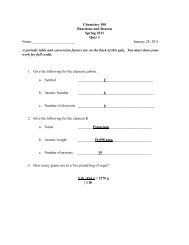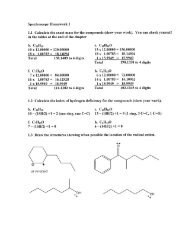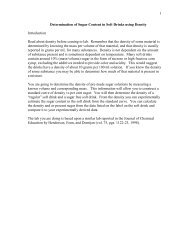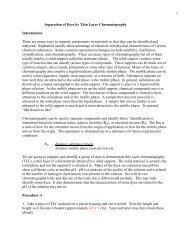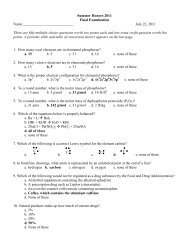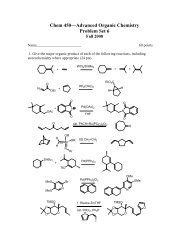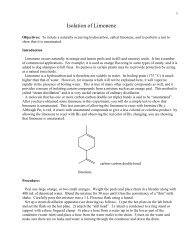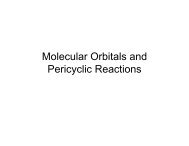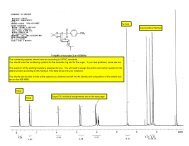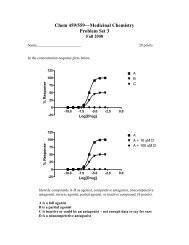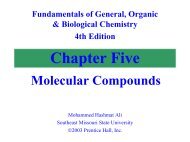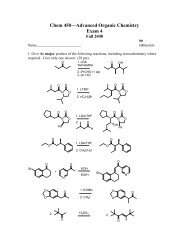Mosher Ester Analysis - Department of Chemistry and Physics
Mosher Ester Analysis - Department of Chemistry and Physics
Mosher Ester Analysis - Department of Chemistry and Physics
Create successful ePaper yourself
Turn your PDF publications into a flip-book with our unique Google optimized e-Paper software.
c. Remove the plate from the tank <strong>and</strong> mark the solvent front with a pencil.<br />
d. Wait for the plate to dry. You can assist this by fanning the plate with a<br />
folder or using a flow <strong>of</strong> dry nitrogen. While you are waiting, you should<br />
be cleaning glassware or something else productive. Do not wait an<br />
excessive amount <strong>of</strong> time. Many compounds are sensitive to oxidation on<br />
a TLC plate as the surface area is very large.<br />
4. Isolate the product.<br />
a. When your plate is dry enough, visualize the b<strong>and</strong>s using UV light. Mark<br />
them lightly with a pencil.<br />
b. Using an exacto knife or the flat edge <strong>of</strong> a spatula, scrape the b<strong>and</strong>s <strong>of</strong>f<br />
onto a lengthwise folded piece <strong>of</strong> clean, white paper.<br />
c. Prepare a vacuum filtration using a fritted glass funnel as shown below.<br />
d. Place the scrapings into a fritted glass funnel <strong>and</strong> press them into a pad.<br />
e. Wash the compound <strong>of</strong>f the silica into a round bottomed flask using 3 x 5<br />
mL <strong>of</strong> TLC solvent.<br />
f. Remove the solvent by rotary evaporation <strong>and</strong> determine the mass <strong>of</strong> your<br />
product. While this is occurring have your sample analyzed by chiral GC<br />
or be cleaning your glassware.<br />
5. Characterize your product by 1 H <strong>and</strong> 19 FNMR.<br />
Since one member <strong>of</strong> your team will prepare the R-MTPA ester <strong>and</strong> the other will<br />
prepare the S-MTPA ester, compare your results <strong>and</strong> assign the stereochemistry <strong>of</strong> the<br />
alcohol <strong>and</strong> the % e.e. according to the two <strong>Mosher</strong> references.<br />
Questions:<br />
1. Compare the % e.e. based on the integration <strong>of</strong> the 1 H <strong>and</strong> the 19 F spectra <strong>of</strong> the<br />
<strong>Mosher</strong> ester you made. For 1 H, calculate for all resonances that are sufficiently<br />
resolved to integrate reliably. Do they agree? If not, suggest a reason for the<br />
discrepancy.<br />
2. Calculate the % e.e. from your crude product <strong>and</strong> compare with that from the<br />
purified sample. Do they agree? If not, suggest a reason for the discrepancy.<br />
3. Compare the % e.e. you obtained to that obtained by your partner. Do they agree?<br />
If not, suggest a reason for the discrepancy.<br />
4. Suggest two alternate methods for determining the % e.e. <strong>of</strong> your alcohol.




